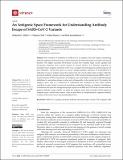An Antigenic Space Framework for Understanding Antibody Escape of SARS-CoV-2 Variants
Author(s)
Miller, Nathaniel L.; Clark, Thomas; Raman, Rahul; Sasisekharan, Ram
Downloadviruses-13-02009.pdf (2.359Mb)
Publisher with Creative Commons License
Publisher with Creative Commons License
Creative Commons Attribution
Terms of use
Metadata
Show full item recordAbstract
The evolution of mutations in SARS-CoV-2 at antigenic sites that impact neutralizing antibody responses in humans poses a risk to immunity developed through vaccination and natural infection. The highly successful RNA-based vaccines have enabled rapid vaccine updates that incorporate mutations from current variants of concern (VOCs). It is therefore important to anticipate future antigenic mutations as the virus navigates the heterogeneous global landscape of host immunity. Toward this goal, we survey epitope-paratope interfaces of anti-SARS-CoV-2 antibodies to map an antigenic space that captures the role of each spike protein residue within the polyclonal antibody response directed against the ACE2-receptor binding domain (RBD) or the N-terminal domain (NTD). In particular, the antigenic space map builds on recently published epitope definitions by annotating epitope overlap and orthogonality at the residue level. We employ the antigenic space map as a framework to understand how mutations on nine major variants contribute to each variant’s evasion of neutralizing antibodies. Further, we identify constellations of mutations that span the orthogonal epitope regions of the RBD and NTD on the variants with the greatest antibody escape. Finally, we apply the antigenic space map to predict which regions of antigenic space—should they mutate—may be most likely to complementarily augment antibody evasion for the most evasive and transmissible VOCs.
Date issued
2021-10Department
Massachusetts Institute of Technology. Department of Biological Engineering; Koch Institute for Integrative Cancer Research at MIT; Harvard University--MIT Division of Health Sciences and TechnologyJournal
Viruses
Publisher
Multidisciplinary Digital Publishing Institute
Citation
Miller, Nathaniel L. et al. "An Antigenic Space Framework for Understanding Antibody Escape of SARS-CoV-2 Variants." Viruses 13, 10 (October 2021): 2009. © 2021 by the authors
Version: Final published version
ISSN
1999-4915